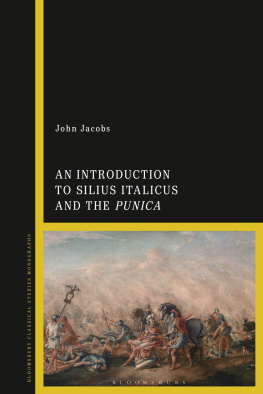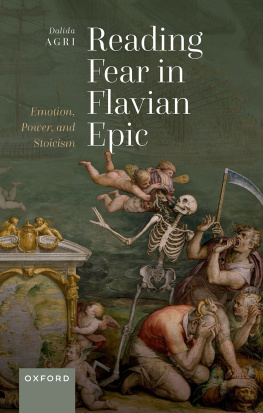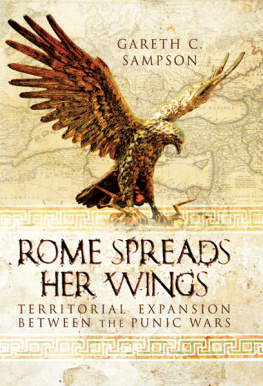
An Introduction to Silius Italicus
and the Punica
FILIO CARISSIMO
Also available from Bloomsbury
A Guide to Reading Herodotus Histories, Sean Sheehan
Hannibal, Robert Garland
Homer: A Guide for the Perplexed, Ahuvia Kahane

Contents
The present volume represents the first of two books on the Roman senator, consul, orator, and poet Silius Italicus and his Latin historical epic, the Punica, which I will be publishing with Bloomsbury Academic. In this book, I offer the first comprehensive introduction in any language to the poet and his poem; in the companion book, I will likewise offer the first comprehensive introduction in any language to their reception and their place in the Classical tradition. This first volume has its (distant) origins in my 2009 Ph.D. dissertation, but also reflects how my thinking about Silius and the Punica has (I hope) evolved over the course of the past decade. As Flavian literature and, in particular, Flavian epic continue to attract more and more attention among both students and scholars, there is a real need for an accessible overview of the poet and his poem. I hope that, in attempting to meet that need, I am at least able to garner the epic even more readers.
I have many students, colleagues, and friends to thank for their advice and support during the past two decades, especially from the many years spent with the Punica. First and foremost, I would like to thank my dissertation advisor at Yale, Chris Kraus, as well as my two readers, Kurt Freudenburg and Bob Cowan. More recently, I would like to thank the many students, parents, and colleagues at the Montclair Kimberley Academy who have sustained me as I completed this project over the past several years. In particular, I would like to thank my Headmaster, Tom Nammack, as well as my Upper School Head of Campus, Dave Flocco. Steve Valentine, Upper School Assistant Head of Campus, offered welcome advice and support at a number of critical junctures. Among other members of the MKA community, I would especially like to thank my colleagues David Hessler and Ron Wolfson; Ron, Carole, and David Reading; and my advisee, Luca Winters. I completed some of the research for this project, and much of the research for the second project, through the generous assistance provided by a PAMKA Faculty Trust Grant.
I would not have written this book if my first department chair, trusted colleague, and valued friend Fred Booth had not invited me to deliver the tenth annual Father Cotter Memorial Lecture at Seton Hall University in April 2016. Having the opportunity to speak about single combat in the Punica that afternoon rekindled my desire to write about the epic and to argue for its importance not only for Flavian literature but also for Classical literature as a whole. Around the same time, I happened to make contact with Alice Wright at Bloomsbury. She has supported both books enthusiastically from the beginning, and I would especially like to thank her, as well as Lily Mac Mahon and Georgina Leighton, for guiding me through the publishing process. I would also like to thank the anonymous readers for the press, as well as my copyeditor, Ben Harris, all of whom made a number of useful and helpful suggestions. Any remaining errors and infelicities are, of course, my own. I am deeply grateful to my friends (and first Latin teachers) Hartley and Susan Schearer, as well as to Steve Elgart, and to my familyto my brother, Michael, and, most of all, to my wife, Kerryfor their love, for their unflagging interest in my work, and for helping me to bring this project to fruition.
Maps 14 are reprinted from Hoyos 2015: xiiixvi with permission of Oxford Publishing Limited through PLSclear.
Map 5 is reprinted from Gabriel 2008: 29 with permission of University of Nebraska Press.
Map 6 is reprinted from Greenhalgh 1975: 141. Every effort has been made to trace the copyright holders and obtain permission to reproduce this material.
All Greek and Latin texts are printed as in the relevant volume of the Bibliotheca Teubneriana or the Oxford Classical Texts unless otherwise noted, apart from minor changes in orthography. Likewise, all translations of these texts into English are my own unless otherwise noted.
Throughout this book, I include references only to the essential scholarship in order to point the reader in the right direction and to keep the number and length of the footnotes to a minimum. I refer the reader to the bibliography at the end of the book for additional guidance. For a complete history of scholarship on Silius Italicus and the Punica, please consult the companion website.
| APh | Lanne philologique (Paris, 1928) |
| LSJ | H. G. Liddell, R. Scott, and H. S. Jones, eds., A GreekEnglish Lexicon, 9th ed., with a revised supplement (Oxford, 1996) |
| OCD4 | S. Hornblower, A. Spawforth, and E. Eidinow, eds., The Oxford Classical Dictionary, 4th ed. (Oxford, 2012) |
| OLD | P. G. W. Glare, ed., Oxford Latin Dictionary, 2nd ed. (Oxford, 2012) |
All abbreviations of Greek authors and titles are those found in LSJ; likewise, all abbreviations of Latin authors and titles are those found in OLD. All other abbreviations are those found either in APh or else in OCD4. I have, in a few cases, simply used the full title for a periodical.






The editio princeps of the Punica was published in Rome on April 5, 1471, with a second Roman edition appearing only three weeks later, on April 26. Together, these editions, translations, and commentaries, along with a host of other works, have all contributed to the establishment of a relatively stable and reliable modern critical text, as well as to the ongoing rediscovery of the poet and his poem by scholars of the Classics and in general.
In a sense, every age has rediscovered Silius Italicus and his Punica in its own way(s), but the dawn of the new millennium shows all the signs of marking the beginning of an aetas Siliana, as scholarship moves beyond the inveterate debate over positive and negative valuations of the poet and his poem to grapple with questions of greater interest and deeper significance.
There are three essential questions which lay at the core of this scholarship and, accordingly, this book: who is Silius Italicus, what is the
Next page














